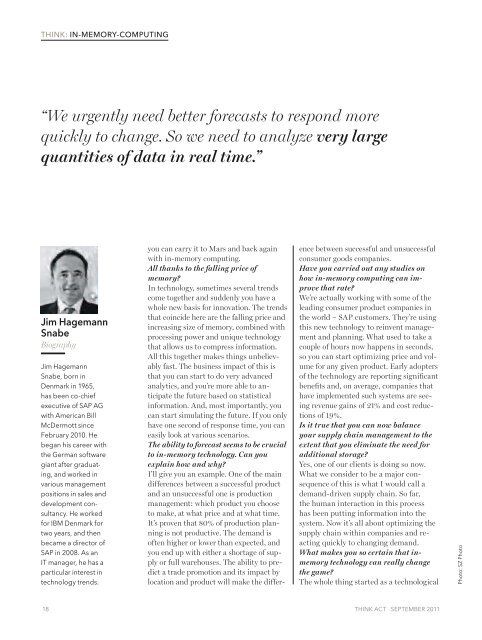Create successful ePaper yourself
Turn your PDF publications into a flip-book with our unique Google optimized e-Paper software.
<strong>THINK</strong>: IN-MEMORY-COMPUTING<br />
“We urgently need better forecasts to respond more<br />
quickly to change. So we need to analyze very large<br />
quantities of data in real time.”<br />
Jim Hagemann<br />
Snabe<br />
Biography<br />
Jim Hagemann<br />
Snabe, born in<br />
Denmark in 1965,<br />
has been co-chief<br />
executive of SAP AG<br />
with American Bill<br />
McDermott since<br />
February 2010. He<br />
began his career with<br />
the German software<br />
giant after graduating,<br />
and worked in<br />
various management<br />
positions in sales and<br />
development consultancy.<br />
He worked<br />
for IBM Denmark for<br />
two years, and then<br />
became a director of<br />
SAP in 2008. As an<br />
IT manager, he has a<br />
particular interest in<br />
you can carry it to Mars and back again<br />
with in-memory computing.<br />
All thanks to the falling price of<br />
memory?<br />
In technology, sometimes several trends<br />
come together and suddenly you have a<br />
whole new basis for innovation. The trends<br />
that coincide here are the falling price and<br />
increasing size of memory, combined with<br />
processing power and unique technology<br />
that allows us to compress information.<br />
All this together makes things unbelievably<br />
fast. The business impact of this is<br />
that you can start to do very advanced<br />
analytics, and you’re more able to anticipate<br />
the future based on statistical<br />
information. And, most importantly, you<br />
can start simulating the future. If you only<br />
have one second of response time, you can<br />
easily look at various scenarios.<br />
The ability to forecast seems to be crucial<br />
to in-memory technology. Can you<br />
explain how and why?<br />
I’ll give you an example. One of the main<br />
differences between a successful product<br />
and an unsuccessful one is production<br />
management: which product you choose<br />
to make, at what price and at what time.<br />
It’s proven that 80% of production planning<br />
is not productive. The demand is<br />
often higher or lower than expected, and<br />
you end up with either a shortage of supply<br />
or full warehouses. The ability to predict<br />
a trade promotion and its impact by<br />
location and product will make the differ-<br />
ence between successful and unsuccessful<br />
consumer goods companies.<br />
Have you carried out any studies on<br />
how in-memory computing can improve<br />
that rate?<br />
We’re actually working with some of the<br />
leading consumer product companies in<br />
the world – SAP customers. They’re using<br />
this new technology to reinvent management<br />
and planning. What used to take a<br />
couple of hours now happens in seconds,<br />
so you can start optimizing price and volume<br />
for any given product. Early adopters<br />
of the technology are reporting significant<br />
benefits and, on average, companies that<br />
have implemented such systems are seeing<br />
revenue gains of 21% and cost reductions<br />
of 19%.<br />
Is it true that you can now balance<br />
your supply chain management to the<br />
extent that you eliminate the need for<br />
additional storage?<br />
Yes, one of our clients is doing so now.<br />
What we consider to be a major consequence<br />
of this is what I would call a<br />
demand-driven supply chain. So far,<br />
the human interaction in this process<br />
has been putting information into the<br />
system. Now it’s all about optimizing the<br />
supply chain within companies and reacting<br />
quickly to changing demand.<br />
What makes you so certain that inmemory<br />
technology can really change<br />
the game?<br />
The whole thing started as a technological<br />
technology trends. Photo: SZ Photo<br />
18 <strong>THINK</strong> <strong>ACT</strong> SEPTEMBER 2011


